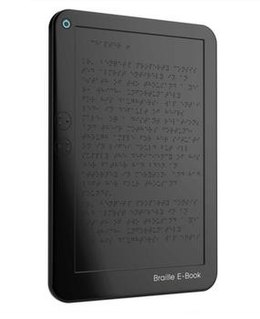 W
WA braille e-book is a refreshable braille display using electroactive polymers or heated wax rather than mechanical pins to raise braille dots on a display. Though not inherently expensive, due to the small scale of production they have not been shown to be economical.
 W
WA braille embosser is an impact printer that renders text as tactile braille cells. Using braille translation software, a document can be embossed with relative ease. This makes braille production efficient and cost-effective.
 W
WA braille watch is a portable timepiece used by the blind or visually impaired to tell time. It is used by touching the dial and noticing the embossments. Both analog and digital versions are available. The analog versions have a protective glass or crystal cover that is flipped open when time needs to be read and the clock-hands are constructed to not be susceptible to movement at the mere touch of the finger that a blind person uses to observe their positions. In the digital form, the dots keep changing position as time changes. In this case, one must understand the Braille alphabet to read the watch.
 W
WA cecogram, also known as literature for the blind, is a letter or a parcel that contains documents or items intended for visually impaired persons. Cecograms can be sent or received by such persons, as well as by organisations that provide assistance to the visually impaired. Cecograms are either partially or entirely exempt from postage.
 W
WThe Mountbatten Brailler is an electronic machine used to type braille on braille paper. It uses the traditional "braille typewriter keyboard" of the Perkins Brailler with modern technology, giving it a number of additional features such as word processing, audio feedback and embossing. The machine was pioneered and developed at the United Kingdom's Royal National College for the Blind in Hereford by Ernest Bate.
 W
WOptical braille recognition is the act of capturing and processing images of braille characters into natural language characters. It is used to convert braille documents for people who cannot read them into text, and for preservation and reproduction of the documents.
 W
WThe Perkins Brailler is a "braille typewriter" with a key corresponding to each of the six dots of the braille code, a space key, a backspace key, and a line space key. Like a manual typewriter, it has two side knobs to advance paper through the machine and a carriage return lever above the keys. The rollers that hold and advance the paper have grooves designed to avoid crushing the raised dots the brailler creates.
 W
WA refreshable braille display or braille terminal is an electro-mechanical device for displaying braille characters, usually by means of round-tipped pins raised through holes in a flat surface. Visually impaired computer users who cannot use a standard computer monitor can use it to read text output. Deafblind computer users may also use refreshable braille displays.
 W
WThe slate and stylus are tools used by blind persons to write text that they can read without assistance. Invented by Charles Barbier as the tool for writing night writing, the slate and stylus allow for a quick, easy, convenient and constant method of making embossed printing for Braille character encoding. Prior methods of making raised printing for the blind required a movable type printing press.
 W
WTactile is a real-time text-to-braille translation device currently under development at the Massachusetts Institute of Technology. It was conceived by a team of undergraduate students, competing as "Team 100% Enthusiasm", during a 15-hour MIT "hackathon". The device is slid over printed text and a camera captures images of the words and sends them to a microcontroller. The information moves the pins up and down, translating the text into Braille. Once on the market it is hoped to be much cheaper than existing devices.